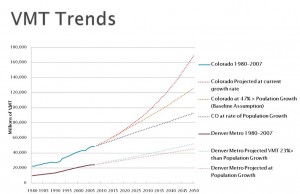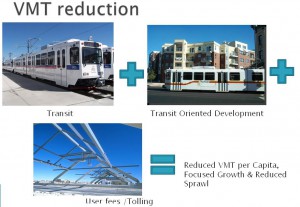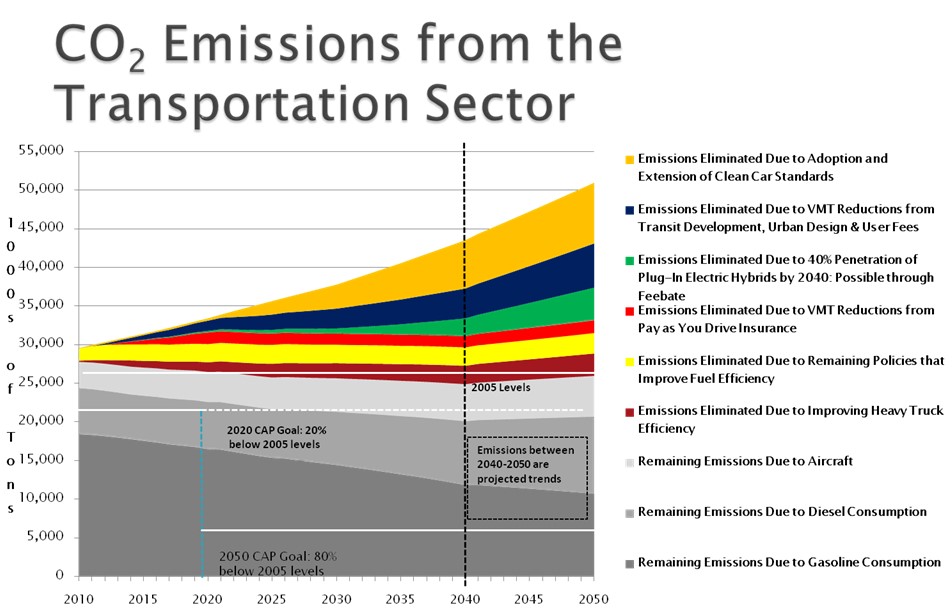Colorado could feasibly reduce carbon dioxide emissions from cars and light trucks 20 percent by 2020 and 80 percent by 2050, if local, state, and federal governments implement the right policies, Bob Yuhnke, Transportation Program Director for the Southwest Energy Efficiency Project (“SWEEP”), declared at a PLAN-Boulder forum on July 26. Indeed, he claimed that such a program would save Coloradans billions of dollars in avoided fuel costs alone. He also noted some hopeful political developments in the state that seem to indicate growing support for at least some elements of that program.
Realistic strategies to achieve this GHG reduction are analyzed in a report called Colorado Transportation Blueprint for the New Energy Economy (“Blueprint”), which was issued by SWEEP in July, 2009. As Bob explained at the PLAN-Boulder forum, the strategies examined by the report were all adopted or proposed as part of 23 state climate action plans and by a few metropolitan planning organizations. The transportation system emits 23 percent of all CO2 in Colorado and is the fastest growing contributor of CO2 emissions.
 The Blueprint relies on the State Demographer’s estimate that the state’s population will grow 87 percent from 5.01 million in 2008 to 9.4 million in 2050. Most of that growth is projected to occur in the Front Range. Vehicle Miles Traveled (“VMT”) have increased 47% faster than the state’s population, and in the Denver metropolitan area VMT have increased at an even faster rate than that. The average vehicular trip in Denver in 1960 was 12 miles, and now it is 23 miles. Bob claimed that the VMT increase had primarily been caused by sprawl.
The Blueprint relies on the State Demographer’s estimate that the state’s population will grow 87 percent from 5.01 million in 2008 to 9.4 million in 2050. Most of that growth is projected to occur in the Front Range. Vehicle Miles Traveled (“VMT”) have increased 47% faster than the state’s population, and in the Denver metropolitan area VMT have increased at an even faster rate than that. The average vehicular trip in Denver in 1960 was 12 miles, and now it is 23 miles. Bob claimed that the VMT increase had primarily been caused by sprawl.
 Three critical strategies of the Blueprint are to reduce VMT by making mass transit conveniently accessible, forcing new residential and commercial development within walking distance of transit stops, and adopting tolls and other highway user fees.
Three critical strategies of the Blueprint are to reduce VMT by making mass transit conveniently accessible, forcing new residential and commercial development within walking distance of transit stops, and adopting tolls and other highway user fees.
Bob asserted that 80 percent of new travel demand in the Denver metropolitan area could be served by mass transit, if new housing and employers are located conveniently close to it. He noted that longer trips tend to be for commuting to and from jobs and claimed that per capita VMT growth could be halted if transit is used for commuting. He said SWEEP has concluded that for mass transit to effectively reduce VMT, new housing and employers would have to be located within no more than a half mile from a transit stop and the number of residential units within that half-mile radius would have to be about 11,000, or a density of about 11 to 12 units per acre.
The Blueprint estimates that if these VMT reduction strategies were fully implemented, by 2035 the additional cost would be $5.3 billion, but the savings would be $4.4 billion in avoided fuel costs and $2.3 billion in avoided infrastructure costs, creating a net savings of $2.4 billion. Furthermore, 31.4 million tons of CO2 emissions would be avoided.
Another crucial strategy explored by the Blueprint is adoption and extension of federal “light-duty vehicle” fuel economy standards. The federal government has recently decreed that fleet fuel efficiency average 35.5 miles per gallon by 2016. The Blueprint anticipates that by 2025 to 2030, the average fuel economy will increase to 54 miles per gallon, which is what California is expected to mandate before 2020.
A further important Blueprint strategy is to accelerate the replacement of older, less efficient vehicles with new, more efficient ones and to promote the use of hybrid and all-electric vehicles. Bob noted that during the next two years, plug-in, hybrid vehicles will be offered in the United States by all the major automobile manufacturers. He asserted that electric motors are 100 percent more efficient than gasoline engines of similar power, and that electric vehicles produce 60 to 70 percent less CO2 than gasoline-powered ones, at the current level of CO2 emissions from the generation of electrical power for the “grid.” He remarked that if all “light-duty vehicles” were hybrid electric, and if the “grid” were completely “de-carbonized,” CO2 emissions from them would be reduced to close to nothing.
Several more strategies are set forth in the Blueprint, although Bob did not elaborate on them at the July 26 forum. These include requiring auto insurance rates to be based in part on the number of miles driven, reducing highway speed limits, mandating energy-efficient replacement tires for light-duty vehicles, compelling efficiency improvements for heavy-duty trucks, and adopting tax credits and/or low interest loan programs for heavy-duty diesel-electric hybrids and longer, heavy trailers.
Overall, the Blueprint claims that if all its strategies are implemented their total costs would be about $12 billion and the total fuel savings about $46 billion by 2040 with a total reduction of CO2 emissions of 277 million tons. Bob explained that these cost and benefit results have already influenced lawmakers, administrators and the DRCOG board positively.
Bob said he had been encouraged by state legislation passed in 2009, which creates a High Performance Transportation Enterprise with authority to implement a comprehensive program of user fees in growth areas around the state and to allocate the resulting revenue to support the development of transit services. He disclosed that he has been further heartened by indications from the executive director of the Colorado Department of Transportation that he wants use that power to finance transit initiatives, which will include a commuter rail line between Denver and Ft. Collins in the north I-25 corridor and also a fixed guideway system between Denver and Eagle in the I-70 corridor.
Although hardly commending the Denver Regional Council of Governments (“DRCOG”) as a model of enlightened transportation policies, Bob did claim that it had made significant advances recently in the transportation area, thanks principally to the efforts of a handful of its 52 board members, including Will Toor and Macon Cowles, representing the County of Boulder and City of Boulder, respectively. Bob stated that DRCOG has adopted a goal of reducing VMT in the Denver metropolitan area by five percent by 2020. He also said it had revised its scheme for determining the priority of proposals for federal funds, so that multi-modal projects and projects that increase density within close proximity to FasTracks will receive higher scores. He said that SWEEP is now trying to assist DRCOG by analyzing how the Blueprint’s strategies could be applied to particular Denver metropolitan area political jurisdictions.
A Recipe for Cutting Colorado’s CO2 Emissions from Transportation
Colorado could feasibly reduce carbon dioxide emissions from cars and light trucks 20 percent by 2020 and 80 percent by 2050, if the local, state, and federal governments implement the right policies, Bob Yuhnke, Transportation Program Director for the Southwest Energy Efficiency Project (“SWEEP”), declared at a PLAN-Boulder forum on July 26. Indeed, he claimed that such a program would save Coloradans billions of dollars in avoided fuel costs alone. He also noted some hopeful political developments in the state that seem to indicate growing support for at least some elements of that program.
Realistic strategies to achieve this GHG reduction are analyzed in a report called Colorado Transportation Blueprint for the New Energy Economy (“Blueprint”), which was issued by SWEEP in July, 2009. As Bob explained at the PLAN-Boulder forum, the strategies examined by the report were all adopted or proposed as part of 23 state climate action plans and by a few metropolitan planning organizations. The transportation system emits 23 percent of all CO2 in Colorado and is the fastest growing contributor of CO2 emissions.
The Blueprint relies on the State Demographer’s estimate that the state’s population will grow 87 percent from 5.01 million in 2008 to 9.4 million in 2050. Most of that growth is projected to occur in the Front Range. Vehicle Miles Traveled (“VMT”) have increased 47% faster than the state’s population, and in the Denver metropolitan area VMT have increased at an even faster rate than that. The average vehicular trip in Denver in 1960 was 12 miles, and now it is 23 miles. Bob claimed that the VMT increase had primarily been caused by sprawl. Three critical strategies of the Blueprint are to reduce VMT by making mass transit conveniently accessible, forcing new residential and commercial development within walking distance of transit stops, and adopting tolls and other highway user fees.
Bob asserted that 80 percent of new travel demand in the Denver metropolitan area could be served by mass transit, if new housing and employers are located conveniently close to it. He noted that longer trips tend to be for commuting to and from jobs and claimed that per capita VMT growth could be halted if transit is used for commuting. He said SWEEP has concluded that for mass transit to effectively reduce VMT, new housing and employers would have to be located within no more than a half mile from a transit stop and the number of residential units within that half-mile radius would have to be about 11,000, or a density of about 11 to 12 units per acre.
The Blueprint estimates that if these VMT reduction strategies were fully implemented, by 2035 the additional cost would be $5.3 billion, but the savings would be $4.4 billion in avoided fuel costs and $2.3 billion in avoided infrastructure costs, creating a net savings of $2.4 billion. Furthermore, 31.4 million tons of CO2 emissions would be avoided.
Another crucial strategy explored by the Blueprint is adoption and extension of federal “light-duty vehicle” fuel economy standards. The federal government has recently decreed that fleet fuel efficiency average 35.5 miles per gallon by 2016. The Blueprint anticipates that by 2025 to 2030, the average fuel economy will increase to 54 miles per gallon, which is what California is expected to mandate before 2020.
A further important Blueprint strategy is to accelerate the replacement of older, less efficient vehicles with new, more efficient ones and to promote the use of hybrid and all-electric vehicles. Bob noted that during the next two years, plug-in, hybrid vehicles will be offered in the United States by all the major automobile manufacturers. He asserted that electric motors are 100 percent more efficient than gasoline engines of similar power, and that electric vehicles produce 60 to 70 percent less carbon dioxide than gasoline-powered ones, at the current level of carbon dioxide emissions from the generation of electrical power for the “grid.” He remarked that if all “light-duty vehicles” were hybrid electric, and if the “grid” were completely “de-carbonized,” carbon dioxide emissions from them would be reduced to close to nothing.
Several more strategies are set forth in the Blueprint, although Bob did not elaborate on them at the July 26 forum. These include requiring auto insurance rates to be based in part on the number of miles driven, reducing highway speed limits, mandating energy-efficient replacement tires for light-duty vehicles, compelling efficiency improvements for heavy-duty trucks, and adopting tax credits and/or low interest loan programs for heavy-duty diesel-electric hybrids and longer, heavy trailers.
Overall, the Blueprint claims that if all its strategies are implemented their total costs would be about $12 billion and the total fuel savings about $46 billion by 2040 with a total reduction of CO2 emissions of 277 million tons. Bob explained that these cost and benefit results have already influenced lawmakers, administrators and the DRCOG board positively.
Bob said he had been encouraged by state legislation passed in 2009, which creates a High Performance Transportation Enterprise with authority to implement a comprehensive program of user fees in growth areas around the state and to allocate the resulting revenue to support the development of transit services. He disclosed that he has been further heartened by indications from the executive director of the Colorado Department of Transportation that he wants use that power to finance transit initiatives, which will include a commuter rail line between Denver and Ft. Collins in the north I-25 corridor and also a fixed guideway system between Denver and Eagle in the I-70 corridor.
Although hardly commending the Denver Regional Council of Governments (“DRCOG”) as a model of enlightened transportation policies, Bob did claim that it had made significant advances recently in the transportation area, thanks principally to the efforts of a handful of its 52 board members, including Will Toor and Macon Cowles, representing the County of Boulder and City of Boulder, respectively. Bob stated that DRCOG has adopted a goal of reducing VMT in the Denver metropolitan area by five percent by 2020. He also said it had revised its scheme for determining the priority of proposals for federal funds, so that multi-modal projects and projects that increase density within close proximity to FasTracks will receive higher scores. He said that SWEEP is now trying to assist DRCOG by analyzing how the Blueprint’s strategies could be applied to particular Denver metropolitan area political jurisdictions.




